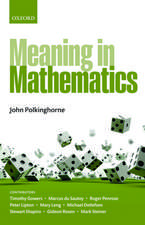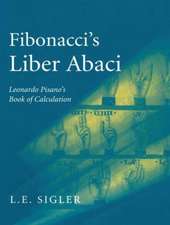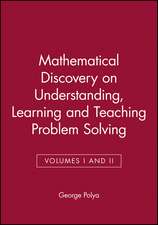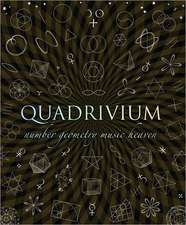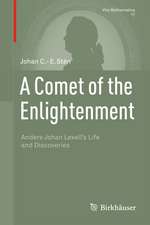Thomas Harriot's Artis Analyticae Praxis: An English Translation with Commentary: Sources and Studies in the History of Mathematics and Physical Sciences
Autor Muriel Seltman, Robert Gouldingen Limba Engleză Hardback – 8 iun 2007
| Toate formatele și edițiile | Preț | Express |
|---|---|---|
| Paperback (1) | 641.20 lei 6-8 săpt. | |
| Springer – 21 noi 2014 | 641.20 lei 6-8 săpt. | |
| Hardback (1) | 645.14 lei 6-8 săpt. | |
| Springer – 8 iun 2007 | 645.14 lei 6-8 săpt. |
Din seria Sources and Studies in the History of Mathematics and Physical Sciences
- 20%
 Preț: 756.13 lei
Preț: 756.13 lei - 18%
 Preț: 907.11 lei
Preț: 907.11 lei - 15%
 Preț: 667.86 lei
Preț: 667.86 lei - 18%
 Preț: 1434.29 lei
Preț: 1434.29 lei -
 Preț: 387.75 lei
Preț: 387.75 lei - 15%
 Preț: 638.57 lei
Preț: 638.57 lei - 18%
 Preț: 896.70 lei
Preț: 896.70 lei - 15%
 Preț: 643.65 lei
Preț: 643.65 lei - 18%
 Preț: 916.25 lei
Preț: 916.25 lei - 18%
 Preț: 1124.92 lei
Preț: 1124.92 lei - 18%
 Preț: 963.29 lei
Preț: 963.29 lei - 15%
 Preț: 652.31 lei
Preț: 652.31 lei - 18%
 Preț: 1244.89 lei
Preț: 1244.89 lei - 23%
 Preț: 686.57 lei
Preț: 686.57 lei - 15%
 Preț: 649.71 lei
Preț: 649.71 lei -
 Preț: 390.25 lei
Preț: 390.25 lei - 15%
 Preț: 644.18 lei
Preț: 644.18 lei - 15%
 Preț: 580.17 lei
Preț: 580.17 lei - 18%
 Preț: 1123.35 lei
Preț: 1123.35 lei - 15%
 Preț: 641.03 lei
Preț: 641.03 lei - 15%
 Preț: 581.14 lei
Preț: 581.14 lei - 18%
 Preț: 796.31 lei
Preț: 796.31 lei - 18%
 Preț: 2119.49 lei
Preț: 2119.49 lei - 24%
 Preț: 860.16 lei
Preț: 860.16 lei -
 Preț: 384.48 lei
Preț: 384.48 lei - 18%
 Preț: 1410.63 lei
Preț: 1410.63 lei - 18%
 Preț: 969.28 lei
Preț: 969.28 lei - 15%
 Preț: 642.03 lei
Preț: 642.03 lei - 18%
 Preț: 1113.71 lei
Preț: 1113.71 lei - 15%
 Preț: 662.16 lei
Preț: 662.16 lei - 18%
 Preț: 963.29 lei
Preț: 963.29 lei - 15%
 Preț: 647.59 lei
Preț: 647.59 lei -
 Preț: 395.63 lei
Preț: 395.63 lei - 18%
 Preț: 941.50 lei
Preț: 941.50 lei - 15%
 Preț: 709.56 lei
Preț: 709.56 lei - 18%
 Preț: 901.26 lei
Preț: 901.26 lei - 15%
 Preț: 695.53 lei
Preț: 695.53 lei - 24%
 Preț: 1294.90 lei
Preț: 1294.90 lei
Preț: 645.14 lei
Preț vechi: 758.99 lei
-15% Nou
Puncte Express: 968
Preț estimativ în valută:
123.44€ • 129.23$ • 102.14£
123.44€ • 129.23$ • 102.14£
Carte tipărită la comandă
Livrare economică 05-19 aprilie
Preluare comenzi: 021 569.72.76
Specificații
ISBN-13: 9780387495118
ISBN-10: 0387495118
Pagini: 299
Ilustrații: VIII, 299 p.
Dimensiuni: 155 x 235 x 20 mm
Greutate: 0.55 kg
Ediția:2007
Editura: Springer
Colecția Springer
Seria Sources and Studies in the History of Mathematics and Physical Sciences
Locul publicării:New York, NY, United States
ISBN-10: 0387495118
Pagini: 299
Ilustrații: VIII, 299 p.
Dimensiuni: 155 x 235 x 20 mm
Greutate: 0.55 kg
Ediția:2007
Editura: Springer
Colecția Springer
Seria Sources and Studies in the History of Mathematics and Physical Sciences
Locul publicării:New York, NY, United States
Public țintă
Academic/professional/technical: Research and professionalCuprins
The Practice of the Analytic Art (translation).- Preface to Analysts.- Definitions.- Section One.- Section Two.- Section Three.- Section Four.- Section Five.- Section Six.- Numerical Exegesis.- Rules for Guidance.- Commentary.- Comparative Table of Equations Solved.- Textual Emendations.
Recenzii
From the reviews:
"The Praxis contains Harriot’s most significant contribution to the theory of equations, the discovery that polynomials can be constructed as products of linear, or sometimes quadratic, factors. … The notes that follow the translation (70 pages) offer a great deal of fine textual detail. They also contain some beautiful reproductions of the original manuscripts … . Seltman and Goulding’s translation is a welcome addition to this growing body of work." (Jackie Stedall, MathDL, September, 2007)
"The book under review is a useful English translation of a mathematically ‘clean’ copy … by Robert Goulding that is enriched by a competent commentary by Muriel Seltman: it makes the mathematical content accessible to the modern reader. To that end, Harriot’s notation has rightly been modernized. … The reader finds a comparative table of equations solved, a list of textual emendations, additional information about the Harriot papers (kept in the British Library), and a select bibliography." (Eberhard Knobloch, Mathematical Reviews, Issue 2008 j)
"Seltman’s and Goulding’s Introduction, Commentary, and Tables are all interesting and useful. … The book contains just three reproductions of Harriot’s original work, each a full-page photograph of one of Harriot’s manuscript sheets on algebra. These are interesting and give the reader a good sense of what it is like to read Harriot’s work in the manuscripts themselves."(Janet Beery, British Society for the History of Mathematics, Vol. 24 March, 2009)
"The Praxis contains Harriot’s most significant contribution to the theory of equations, the discovery that polynomials can be constructed as products of linear, or sometimes quadratic, factors. … The notes that follow the translation (70 pages) offer a great deal of fine textual detail. They also contain some beautiful reproductions of the original manuscripts … . Seltman and Goulding’s translation is a welcome addition to this growing body of work." (Jackie Stedall, MathDL, September, 2007)
"The book under review is a useful English translation of a mathematically ‘clean’ copy … by Robert Goulding that is enriched by a competent commentary by Muriel Seltman: it makes the mathematical content accessible to the modern reader. To that end, Harriot’s notation has rightly been modernized. … The reader finds a comparative table of equations solved, a list of textual emendations, additional information about the Harriot papers (kept in the British Library), and a select bibliography." (Eberhard Knobloch, Mathematical Reviews, Issue 2008 j)
"Seltman’s and Goulding’s Introduction, Commentary, and Tables are all interesting and useful. … The book contains just three reproductions of Harriot’s original work, each a full-page photograph of one of Harriot’s manuscript sheets on algebra. These are interesting and give the reader a good sense of what it is like to read Harriot’s work in the manuscripts themselves."(Janet Beery, British Society for the History of Mathematics, Vol. 24 March, 2009)
Textul de pe ultima copertă
The present work is the first ever English translation of the original text of Thomas Harriot's Artis Analyticae Praxis, first published in 1631 in Latin. Thomas Harriot's Praxis is an essential work in the history of algebra. Even though Harriot's contemporary, Viete, was among the first to use literal symbols to stand for known and unknown quantities, it was Harriott who took the crucial step of creating an entirely symbolic algebra. This allowed reasoning to be reduced to a quasi-mechanical manipulation of symbols. Although Harriot's algebra was still limited in scope (he insisted, for example, on strict homogeneity, so only terms of the same powers could be added or equated to one another), it is recognizably modern.
While Harriot's book was highly influential in the development of analysis in England before Newton, it has recently become clear that the posthumously published Praxis contains only an incomplete account of Harriot's achievement: his editor substantially rearranged the work before publishing it, and omitted sections that were apparently beyond comprehension, such as negative and complex roots of equations.
The commentary included with this translation attempts to restore the Praxis to the state of Harrios draft. The authors based their work on manuscripts in the British Library, Pentworth House, and Lambeth Palace, and the commentary explores some of Harriot's most novel and advanced mathematics, very little of which has been published in the past. This publication will become an important contribution to the history of mathematics, and it will provide the basis for a reassessment of the development of algebra.
The present work is the first ever English translation of the original text of Thomas Harriot’s Artis Analyticae Praxis, first published in 1631 in Latin. Thomas Harriot’s Praxis is an essential work in the history of algebra. Even though Harriot’s contemporary, Viete, was amongthe first to use literal symbols to stand for known and unknown quantities, it was Harriott who took the crucial step of creating an entirely symbolic algebra. This allowed reasoning to be reduced to a quasi-mechanical manipulation of symbols. Although Harriot’s algebra was still limited in scope (he insisted, for example, on strict homogeneity, so only terms of the same powers could be added or equated to one another), it is recognizably modern.
While Harriot’s book was highly influential in the development of analysis in England before Newton, it has recently become clear that the posthumously published Praxis contains only an incomplete account of Harriot’s achievement: his editor substantially rearranged the work before publishing it, and omitted sections that were apparently beyond comprehension, such as negative and complex roots of equations.
The commentary included with this translation relates the contents of the Praxis to the corresponding pages in his manuscript papers, which enables much of Harriot's most novel and advanced mathematics to be explored. This publication will become an important contribution to the history of mathematics, and it will provide the basis for a reassessment of the development of algebra.
While Harriot's book was highly influential in the development of analysis in England before Newton, it has recently become clear that the posthumously published Praxis contains only an incomplete account of Harriot's achievement: his editor substantially rearranged the work before publishing it, and omitted sections that were apparently beyond comprehension, such as negative and complex roots of equations.
The commentary included with this translation attempts to restore the Praxis to the state of Harrios draft. The authors based their work on manuscripts in the British Library, Pentworth House, and Lambeth Palace, and the commentary explores some of Harriot's most novel and advanced mathematics, very little of which has been published in the past. This publication will become an important contribution to the history of mathematics, and it will provide the basis for a reassessment of the development of algebra.
The present work is the first ever English translation of the original text of Thomas Harriot’s Artis Analyticae Praxis, first published in 1631 in Latin. Thomas Harriot’s Praxis is an essential work in the history of algebra. Even though Harriot’s contemporary, Viete, was amongthe first to use literal symbols to stand for known and unknown quantities, it was Harriott who took the crucial step of creating an entirely symbolic algebra. This allowed reasoning to be reduced to a quasi-mechanical manipulation of symbols. Although Harriot’s algebra was still limited in scope (he insisted, for example, on strict homogeneity, so only terms of the same powers could be added or equated to one another), it is recognizably modern.
While Harriot’s book was highly influential in the development of analysis in England before Newton, it has recently become clear that the posthumously published Praxis contains only an incomplete account of Harriot’s achievement: his editor substantially rearranged the work before publishing it, and omitted sections that were apparently beyond comprehension, such as negative and complex roots of equations.
The commentary included with this translation relates the contents of the Praxis to the corresponding pages in his manuscript papers, which enables much of Harriot's most novel and advanced mathematics to be explored. This publication will become an important contribution to the history of mathematics, and it will provide the basis for a reassessment of the development of algebra.
Caracteristici
Contains errata for the original text, as well as commentary and historical information First modern translation of the 17th century's most important mathematician Includes supplementary material: sn.pub/extras



